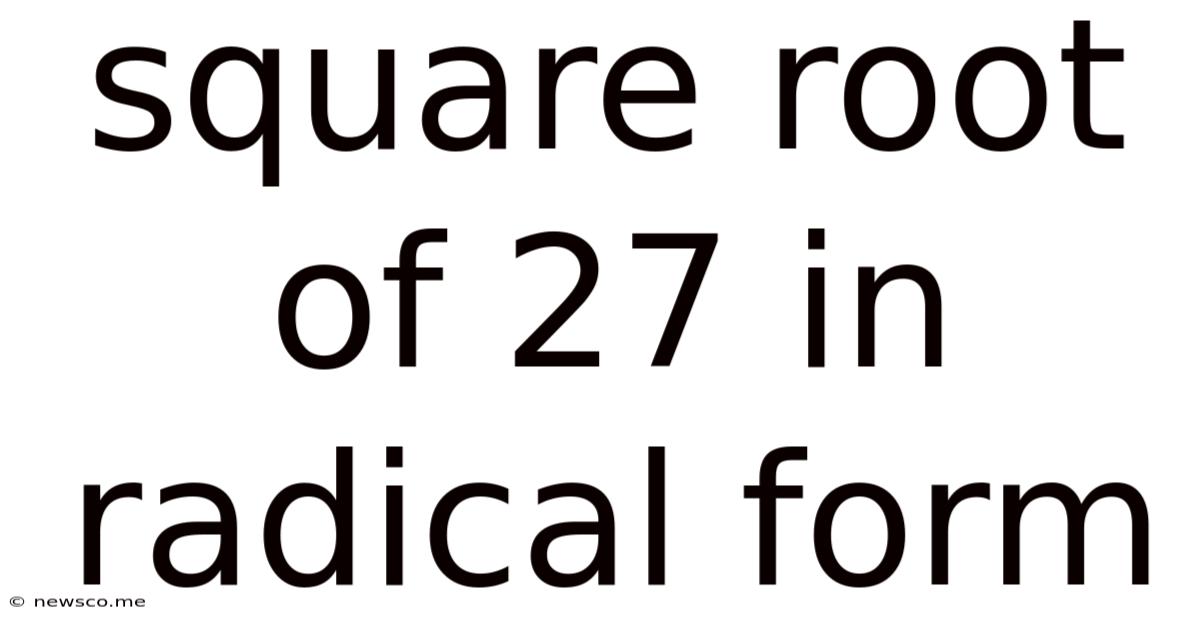Square Root Of 27 In Radical Form
News Co
Apr 20, 2025 · 4 min read

Table of Contents
Understanding the Square Root of 27 in Radical Form
The square root of 27, often written as √27, is an interesting mathematical concept that delves into the world of radicals and simplifying expressions. While a calculator can readily provide a decimal approximation, understanding how to express √27 in its simplest radical form is crucial for building a solid foundation in algebra and higher-level mathematics. This article will explore various methods of simplifying √27, explaining the underlying principles and providing further examples to solidify your understanding.
What is a Radical?
Before diving into the simplification of √27, let's clarify what a radical is. In mathematics, a radical, often represented by the symbol √ (a radical sign or radix), denotes a root of a number. The number inside the radical sign is called the radicand. The small number placed to the upper-left of the radical sign, called the index, indicates the type of root. For instance, √27 represents the square root of 27 (index is 2, often omitted), while ³√27 represents the cube root of 27 (index is 3). Simplifying a radical involves reducing the radicand to its simplest form while retaining the radical expression's value.
Prime Factorization: The Key to Simplifying Radicals
The most effective method for simplifying radicals like √27 involves prime factorization. Prime factorization is the process of expressing a number as a product of its prime factors. Prime factors are numbers greater than 1 that are only divisible by 1 and themselves (e.g., 2, 3, 5, 7, 11, etc.).
Let's find the prime factorization of 27:
- 27 is divisible by 3: 27 = 3 × 9
- 9 is also divisible by 3: 9 = 3 × 3
- Therefore, the prime factorization of 27 is 3 × 3 × 3, or 3³.
Simplifying √27
Now that we have the prime factorization of 27 (3³), we can rewrite √27 as √(3³). Remember that the square root of a number is essentially finding a value that, when multiplied by itself, equals the original number. We can use the property of radicals that states √(a × b) = √a × √b to simplify the expression.
√(3³) can be rewritten as √(3² × 3). Using the property mentioned above:
√(3² × 3) = √(3²) × √3 = 3√3
Therefore, the simplest radical form of √27 is 3√3. This means that 3√3, when multiplied by itself (3√3 × 3√3), equals 27.
Further Examples of Radical Simplification
Let's explore a few more examples to strengthen your understanding of radical simplification using prime factorization:
Example 1: Simplifying √48
- Prime Factorization: 48 = 2 × 2 × 2 × 2 × 3 = 2⁴ × 3
- Rewrite the radical: √48 = √(2⁴ × 3)
- Apply the radical property: √(2⁴ × 3) = √(2⁴) × √3 = 2²√3 = 4√3
Therefore, √48 simplified is 4√3.
Example 2: Simplifying √72
- Prime Factorization: 72 = 2 × 2 × 2 × 3 × 3 = 2³ × 3²
- Rewrite the radical: √72 = √(2³ × 3²)
- Apply the radical property: √(2³ × 3²) = √(2² × 2 × 3²) = √(2²) × √(3²) × √2 = 2 × 3 × √2 = 6√2
Therefore, √72 simplified is 6√2.
Example 3: Simplifying √108
- Prime Factorization: 108 = 2 × 2 × 3 × 3 × 3 = 2² × 3³
- Rewrite the radical: √108 = √(2² × 3³)
- Apply the radical property: √(2² × 3³) = √(2²) × √(3² × 3) = 2 × 3√3 = 6√3
Therefore, √108 simplified is 6√3.
Adding and Subtracting Radicals
Once you've mastered simplifying radicals, you can apply this knowledge to more complex algebraic operations. For instance, you can add and subtract radicals, but only if they have the same radicand and index. Let's look at an example:
Example: Simplify 3√3 + 2√3
Since both terms have the same radicand (3) and index (2, implied), we can add them directly:
3√3 + 2√3 = (3 + 2)√3 = 5√3
Multiplying and Dividing Radicals
Similar to addition and subtraction, multiplying and dividing radicals requires understanding and application of their properties:
Multiplication: √a × √b = √(a × b)
Division: √a / √b = √(a / b)
Example: Simplify (√27)(√3)
- Multiply the radicands: (√27)(√3) = √(27 × 3) = √81
- Simplify: √81 = 9
Applications of Radical Simplification
Simplifying radicals isn't just an academic exercise; it has practical applications in various fields, including:
- Geometry: Calculating lengths, areas, and volumes of geometrical figures often involves simplifying radicals.
- Physics: Many physical formulas include radicals, particularly those related to motion, energy, and waves.
- Engineering: Engineers frequently use radicals in calculations related to structural design and fluid dynamics.
Conclusion
Understanding how to express the square root of 27 in its simplest radical form – 3√3 – is a fundamental skill in mathematics. The ability to simplify radicals is crucial for solving algebraic equations, tackling geometrical problems, and comprehending various scientific and engineering concepts. By mastering prime factorization and applying the properties of radicals, you can confidently simplify complex radical expressions and build a stronger mathematical foundation. Remember to practice regularly to solidify your understanding and enhance your problem-solving skills. The more you work with radicals, the more intuitive the simplification process will become.
Latest Posts
Related Post
Thank you for visiting our website which covers about Square Root Of 27 In Radical Form . We hope the information provided has been useful to you. Feel free to contact us if you have any questions or need further assistance. See you next time and don't miss to bookmark.